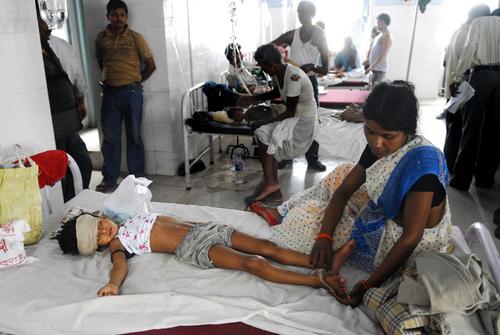India fiddles while hundreds die from routine epidemics
An Indian woman attends to a child lying in a bed of a hospital in Muzzafarapur, some 100kms north of Patna on June 23, 2011. A deadly fever believed to be caused by a type of encephalitis has killed as many as 40 children in an impoverished region of eastern India, health experts said. The children died during the past week in the eastern Indian state of Bihar’s Muzaffarpur district after experiencing high fevers followed by convulsions and unconsciousness, prompting the federal government to rush medical teams to the state.
The death toll is nearing 1000 from India's annual outbreak of Japanese encephalitis — which is touted as a "mystery fever" every year — but there's little or no sign that anything will be any different next season.
According to the Times of India, the central government has hardly increased funding for major vector-borne diseases (which are spread by parasites like mosquitoes) over the past three years. In fact, as a percentage of the overall rural health budget, spending on these diseases actually fell from 3 percent to 2 percent between 2007-08 and 2011-12, the paper said.
Meanwhile, India faces "over 1.5 million confirmed cases of malaria every year. Last year, confirmed dengue cases increased to over 28,000. Chikunguniya is moving cyclically with cases touching up to 50,000 every 2-3 years. And Japanese encephalitis kills anywhere between 500 and 1,000 children every year. And these are just the reported cases, which are a fraction of the actual numbers since few are able to reach hospitals."
State governments' reaction has been even more pathetic, the paper said.
In Uttar Pradesh, which has accounted for 500 encephalitis deaths this year alone and has been the epicenter of the disease for 30 years, the state government has not spent some $20 million of the $110 million it received from the National Vector-Borne Disease Control Program, while neighboring Bihar failed to spend $1 million of its funding.
The article you just read is free because dedicated readers and listeners like you chose to support our nonprofit newsroom. Our team works tirelessly to ensure you hear the latest in international, human-centered reporting every weekday. But our work would not be possible without you. We need your help.
Make a gift today to help us reach our $25,000 goal and keep The World going strong. Every gift will get us one step closer.
